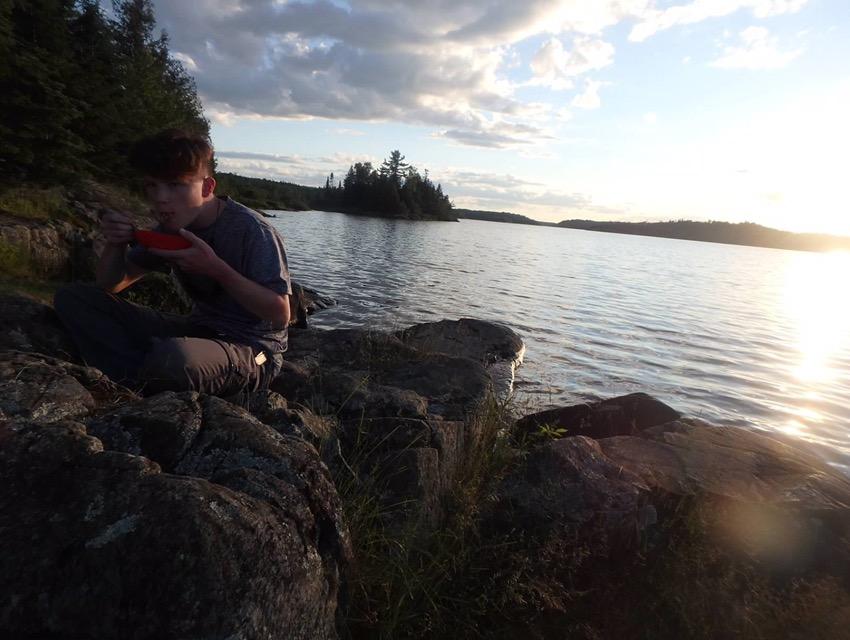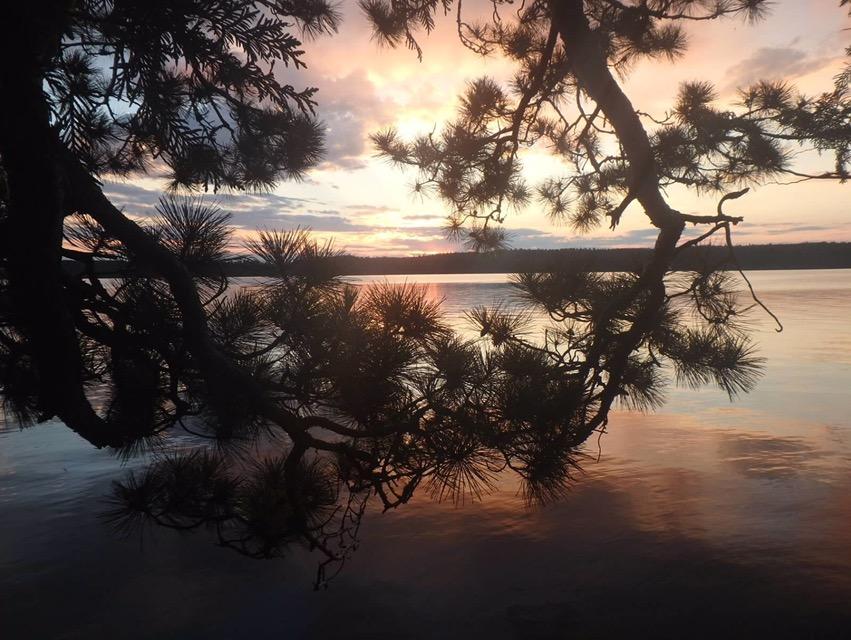My Time in the Minnesota Boundary Waters
In July 2017, my friend Parker and I took a trip to Ely, Minn. to explore the Boundary Waters with the Order of the Arrow, an extension of the Boy Scouts of America.
Our first flight ever chaperoned us to Minneapolis, where a van carrying the other participants picked us up and drove us to Ely. Upon our arrival, we were welcomed by our foremen John and Andrew.
We made introductions, took a quick tour, and were debriefed on the crouch-and-hurl method of lifting a canoe. I had heard from my barber that the mosquitoes were intense in Minnesota, but none of us had seen a single one yet.
After learning the different paddle strokes and reaching our first camp, the mosquitoes emerged. By nightfall, hundreds—no, thousands—swarmed out of thin air to form their own tornado of destruction. Hearing and seeing them even in Texas is a constant reminder of their violent nature in the Boundary Waters.

Parker Lynas eats oatmeal on the shoreline of the Boundary Waters before working.
Our first day of work was pretty simple, being introduced to a plethora of various tools as well as how to use them. For two days, we installed a 2-foot rock—which weighed easily over 200 pounds—into the trail to form a natural step and pounded heaps of rocks into gravel to help secure it in place. It was quite a strenuous process.
We were taught every day at meals the principles of Leave No Trace—leave only footprints, take only pictures and be prepared.
The following day, we approached a campsite on a cliff as rain clouds gathered above, so we set up camp. Not only was the water too deep to pick up the canoe normally, but the climb up to the campsite was steep.
After we managed to set up, the foremen took us on a little tour of the area. We had to climb a small cliffside. After reaching the top, I was greeted by a very, very durable tree, giving me a mild concussion and a charming little scar on my forehead. The next day I felt completely awful, but I got over it soon enough.
One day later, one of our brilliant foremen saw rapids along our path and decided we could take it on. We couldn’t.
As we bobbed through the current, our canoe started drifting to the left. Up ahead, I noticed a dry shrub peeking out from the side, and, forgetting my experience with a tree two days prior, I challenged it to a strength contest. I extended my paddle to push it away and it countered by spitting it back into my face, swatting the paddle into the water.
So, there I was, continuing down the rapids, with only one paddle steering, and a bigger shrub approached us. Knowing the raw power of Minnesota flora, I ducked right and instantly capsized the boat. Now all three of us were in the water, and the canoe started to turn sideways in the rapids. It pinned us under for a second, we reached the bottom of the rapids, and Parker was nowhere to be found.
As it turns out, he happened to flee from the scene, latched onto another canoe. Fatigued and hungry, Keiran—the other passenger in the boat—and I pulled the canoe to the side, emptied the water and the cargo bags, and resumed our voyage like nothing happened.
The next day, after we had portaged down the side of a waterfall, we stopped at another island for lunch. This retreat happened to have wild blueberries and raspberries, as well as an open toilet with barely any mosquitoes (all toilets in the Boundary Waters are essentially just holes). If I was surveying my defecation experiences, I would probably rate it number one. The butterflies, berries, birds and lack of buzzing sounds made for a very relaxing poop. That toilet even had its own paper roll!
The day before we crossed the Canadian border, we stayed at American Point, which an hour later produced the most beautiful view of the sunset I’ve ever seen to this day. Two days later, we hung out in a large secluded waterfall, clothes and all. It was truly a once-in-a-lifetime experience.

Sunset overlooking the border between America and Canada at American Point, M.N.
On our last full day in the Boundary Waters, we reflected in solitude about our time on the voyage. I chose to lay on a bed of yellow, blue and pink moss, and just watched the clouds. Every few minutes I could hear a loon cry nearby or see an eagle swoop down with its dark figure towering ahead. The rain rolled in, and by that point the mosquitoes were of no concern to us.
The arrival back to base camp was sort of melancholic, not only that the journey had reached its end but that we may never see each other again. All of us, now Northmen, split our separate ways in hopes that we would one day meet again.
You can read about the OA Wilderness Voyage program here. To take this voyage yourself, you must be part of the Order of the Arrow from age 16-21.
If you are not, you can still travel through the Boundary Waters with friends or family. You can find information about it here.










